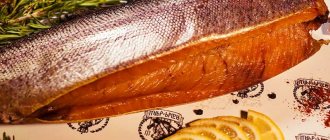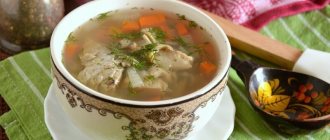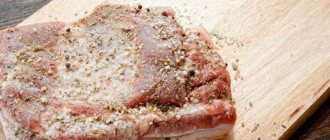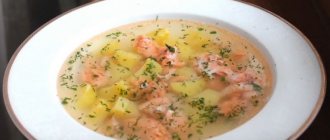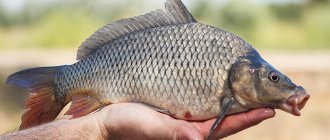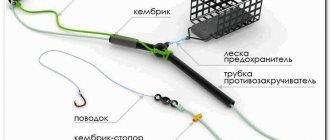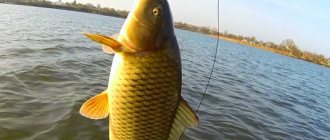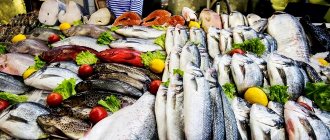Carp is an unpretentious, hardy and omnivorous fish, which is why it is most often bred in home ponds and in swimming pools at the dacha. But raising carp cannot be called easy, so for beginners we will tell you in detail about where it is better to keep fish, how to raise them, what to feed them and how many times a day.
Are you preparing carp fish?
- Yes 83%, 2435 votes
2435 votes 83%2435 votes - 83% of all votes
- No 9%, 252 votes
252 votes 9%
252 votes - 9% of all votes
- I will cook according to your recipes 4%, 130 votes
130 votes 4%
130 votes - 4% of all votes
- I don't eat fish 3%, 101 votes
101 votes 3%
101 votes - 3% of all votes
Total votes: 2918
26.06.2020
×
You or from your IP have already voted.
Features, advantages and disadvantages of carp breeding
Fish farming, including carp, has its own risks, positive aspects and characteristic situations. The undoubted advantages of carp farming include:
- no need for a deep reservoir;
- rapid growth of carp;
- unpretentiousness to living conditions;
- carp is omnivorous, which makes feeding easier;
- tasty fish meat with a small number of bones;
- high consumer demand.
There are also difficulties in keeping carp:
- the fish begins to get sick if there is a lot of it in the reservoir;
- The initial investment of money will be justified only after 1-2 years, when the fry matures and gains weight.
A special feature of carp is their heat-loving nature: representatives of this species feed normally and reproduce only in well-heated water. Therefore, the reservoir for them should be located half in the sun and half in the shade, so that the fish are not cold, but have the opportunity to get away from the scorching rays.
Features of carp spawning
The spawning process occurs mainly in the morning, especially as soon as the sun rises. When the sun just rises, the fish begin to visibly squirm, as if preparing themselves for spawning. By noon everything stops.
Females are accompanied by two to four small moloshniks. They take a long time to choose a suitable place for spawning and look for grass thickets. Sometimes females stop in areas where there is very little water, this happens in order to better fit themselves in this place. But as the water recedes, the fish dies; it is unable to get out to its native abode.
Description of fish and selection of the best breed
Carp (Cyprinus carpio) is a freshwater fish of the carp family, genus Carp. Distributed in the temperate latitudes of Russia, Ukraine, Moldova and Southeast Asia, which is the homeland of the family. There are 27 species of the carp genus.
Semi-wild carp are called carp. This fish is a long-liver and can grow up to 50 years. For cultivation in artificially created conditions, the following are usually chosen:
- Mirror carp . They are capable of reaching particularly large sizes - up to 1 meter in length and more than 50 kilograms of weight. Such giants are rare, but from these data one can judge the average size of mirror carp. Representatives of this species gain weight exclusively in warm water. Among mirror carps, a distinction is made between linear and framed.
- Naked carp . It is named so for a reason - its body is not covered with scales. Of all food species, it is the most demanding in terms of conditions.
- Scaly carp (common) . The most unpretentious carp, this is usually where commercial breeding begins.
Mirror carp
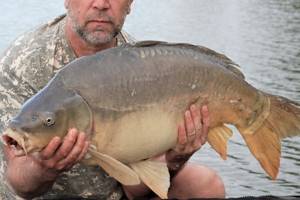
naked carp
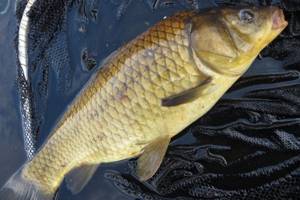
Scaly (common) carp
In Japan, koi carp is very popular, but it is valued for its decorative scales, colored with black, red and orange spots in unpredictable combinations. Koi are released into garden ponds or large fountains.
Description of carp fish and its features
Carp is a large fish, a subspecies of carp, bred artificially, and has a yellow color with a greenish or brown tint. Many sources claim that its lifespan reaches 30 years, and its maximum weight reaches 50 kg. The peculiarities of this development are due to the omnivorous nature of this species; in addition, the word “carp” translated from Greek means “harvest” due to the ability to lay and fertilize up to a million eggs.
Before individuals grow up, they unite in flocks, each of which can number several hundred individuals. Adult fish prefer solitude, with the exception of wintering, which they endure by gathering in small groups. During the winter, the carp is in a half-asleep state; usually at this time it goes deeper and hides in holes until the end of March or beginning of April. The food for this fish is reeds, crustaceans, eggs, various insects, small fish and worms.
There are several types of carp:
- mirror;
- koi (brocade);
- scaly;
- ordinary;
- naked.
In stores in the Russian Federation, as a rule, you can find common carp or mirror carp. Growing this fish is very profitable due to its unpretentiousness, ability to feed on food of both animal and plant origin, and rapid growth. In approximately 2 years, carp grows to 1.5–2 kilograms, corresponding to marketable weight. As a product, it is distinguished by a large content of high-quality tasty meat, the only drawback of which is a large number of small bones, which is the reason for its lack of demand among some people.
Choosing a growing location
Carp can live safely in different bodies of water: both in a lake and in a river. But fish farms usually use artificial ponds. In recent years, convenient swimming pools have been created for home fish breeding. The main thing is to properly arrange the bottom and saturate the water with oxygen. The location for the reservoir should be chosen as far as possible from sources of noise and not in a low-lying area where dirty water can flow during rainfalls and floods.
Pond
Some people already have their own pond on their farm. In this case, its condition is assessed according to the requirements for carp keeping. When digging a new reservoir, the following rules are taken into account:
- Depth no more than 3 meters. Carps love warmth, and the sun does not warm up well in depth.
- Width and length – 3x3 meters.
- It is necessary to plant vegetation near the shore to keep the soil from sliding into the pond, and trees will also create the shade required on hot days.
- It is recommended to fill the bottom with sand, then fill it with concrete, stretch a rubber film over it, and then run water.
- The water needs to be populated with microorganisms and algae. The easiest way is to bring a couple of buckets from a natural fresh water body. In a few months the pond itself will be filled with life. The second option is to purchase and sow algae.
- Fish should only be allowed in when the water temperature is above 24 degrees Celsius.
Protect the pond from birds! They carry pathogens and viruses.
Pool
It is much more convenient to breed carp in a pool, because it is much easier to monitor the condition of the fish, create comfortable conditions, and maintain the purity of the water.
The pool can be purchased or filled on site yourself. At this time, silo pools with vertical water supply are the most popular. The material from which the container is made is not significant. The optimal depth is 1.5 meters.
Before releasing the fish, just like a pond, the pool must be populated with microorganisms. The methods are the same - water from a natural pond, or sowing.
The main thing is to maintain oxygen saturation of the water in the pool.
Read more about how to grow fish in a pool here.
What to do in winter with carp in a pond
- In winter, carp can overwinter in a pool dug into the ground or a solid concrete pool, provided that the container does not freeze to the bottom and a sufficient amount of oxygen gets into it
- In order to prevent the container from freezing after an ice cover strong enough for walking has formed on it, it must be covered with a large layer of snow, or, if there is none, with insulation mats and film, providing places for drilling holes
- In order for oxygen to enter the pool in its ice cover, it is necessary to make several holes and make sure that they do not freeze
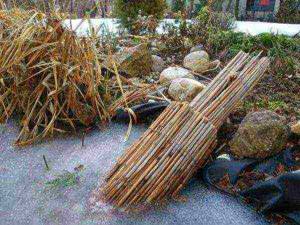
Reeds will prevent thick ice from freezing and provide oxygen to the fish.
- If the container is located indoors or in a greenhouse, then for the winter the feeding of the carp should be reduced , feeding should be done depending on the activity of the fish
Equipment for carp breeding
The minimum required for carp to live includes proper water and warmth. But there are devices that will make caring for fish easier and help increase the number of offspring:
- cages and cage lines;
- filters for water;
- aeration system;
- compressors;
- oximeter;
- oxygen generator;
- automatic fish feeders;
- barrels and pumps;
- water recycling system;
- incubators for hatching fry from eggs;
- bottom cleaners;
- sterilizers;
- instruments for testing water composition;
- backlight
Costs and profits when growing carp
To raise fry in a small reservoir, the average cost is 30,000 rubles. The amount includes the purchase of fry and food during the growing period.
Profit depends on the size of the fish and its presentation. In a pool with a diameter of 3 meters you can grow 600-700 individuals weighing up to 1 kg. Carp meat is a popular product, so you can get from 80,000 rubles when selling fish.
Let's celebrate! Thus, the profit is from 50,000 rubles. At the same time, for re-stocking there is no need to purchase fry; you can use the natural reproduction of adults.
Conditions of detention
Common carp is one of the most unpretentious fish. But, like any other living creature, it needs conditions in which the fish will be comfortable so that it can grow and reproduce.
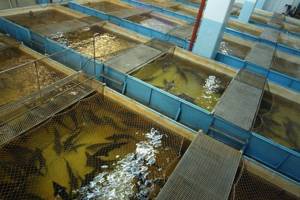
Water and its oxygen content
Ideally, you need to create an imitation of running water in a reservoir, but with a low flow speed. To do this, two pipes are installed: from the pond/pool and into it. One, smaller in diameter, will introduce clean water, thanks to a filter with a pump, the other will release it. You can take water from a clean river, stream, or well. It must be drained into the sewer. There should also be a filter on the drain to prevent fish from getting through.
Water from the central water supply is not suitable, as it has been chlorinated and contains a lot of salts.
The oxygen content should not fall below 3 milligrams per liter. This parameter is determined using a special device - an oximeter. To increase the gas content, oxygen generators, aerators or compressors are used. They sink to the bottom and release oxygen into the water. Reduces its level by contamination of the bottom with fish excrement and rotting plants.
Temperature
In the warm season, the water warms up on its own. But you need to monitor the temperature. It should not fall below +22 degrees and rise above +30 Celsius. Thermal processes are regulated by draining and supplying fresh water.
Carp food
It is recommended to give preference to natural food. Such food includes aquatic vegetation, as well as numerous organisms that live in the pond.
The most popular options are benthos or plankton.
- Plankton refers to organisms that live in the water column and do not sink to the very bottom. Plankton moves in stagnant water.
- Benthos are numerous organisms living at the very bottom.
- Fish larvae, as well as insects, single-celled organisms, crustaceans - this is an ideal option for those who do not want to spend too much money on buying food.
- You can also pay attention to invertebrate organisms. They contain a large amount of protein and carbohydrates, so they will be useful for carp at any stage of development.
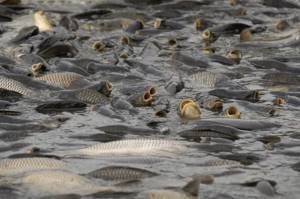
How to breed carp?
Having prepared the reservoir and equipped it with the necessary equipment, you can start fishing directly. Step one is to decide on the type of carp.
It is recommended to take a species characteristic of the region where the fishery is being created.
Purchase of fry
It is safest to purchase fry from those who already successfully breed carp. At the same time, you can look at the life of a fish farm and make sure the fish are healthy. Before purchasing, you should familiarize yourself with the licenses and certificates of the seller.
An order for fry can be made from another region and delivered in a special way in tanks, buckets, or cans. They are filled either with water from a pond or rainwater.
When to put fish in a pond
The ideal period for launching fry into the water is the end of April - beginning of May. But the water should warm up to +22-24 degrees Celsius, which means artificial heating may be required.
Special carp
In nature there are carps that cannot reproduce; these are considered sterile. They have milk on one side and a caviar sac on the other.
Such fish is often found on household tables and is considered the most delicious and fatty. If you have the opportunity, be sure not to miss the chance to try and enjoy such carp.
From spawning to maturity, fish go through a long and dangerous path:
- dry out when exposed to sunlight;
- birds and their relatives eat.
But this is how nature works and nothing can be done about it. So, let's at least show a little conscientiousness and not catch any more small fish that are not fully mature. Let it take some time to catch a great trophy later. Catching fish during the spawning period is strictly prohibited!
How and what to feed carp?
Carp feed only in warm water twice a day. It is better to feed in the morning, as soon as the sun's rays warm the water, and in the evening before sunset. But these recommendations do not apply to all methods of feeding carp - there are 3 of them:
- Extensive type . The pond is populated with natural flora and fauna (not including other fish). Carp feed completely on their own. By choosing this method, you can guarantee environmentally friendly fish meat, but the carp will gain weight slowly.
- Intensive type. Feeding is done with artificial feed for pigs or poultry with a protein content of at least 30%. The fish will quickly gain weight. But the taste of the carp will deteriorate, and the pond will have to be frequently cleaned of food residues.
- Semi-intensive type . The golden mean in feeding carp. The fish feeds on the natural population of the reservoir and receives complementary food. They can be bread, oats, corn, wheat, maggots, larvae, bloodworms, earthworms, legumes.
A nutritious diet will turn a fry into an adult fish weighing half a kilogram in 9 months.
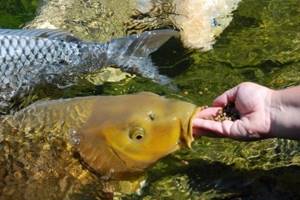
Pros and cons of growing carp
The independent process of growing fish is a complex task that requires constant monitoring and control of the living conditions of the fish. Breeding can have some disadvantages and advantages.
Advantages:
- carp grows quickly, which allows you to get individuals weighing up to 500 grams in the first year of cultivation;
- carp is not picky about the type of food;
- the type of fish is not picky about living conditions;
- the product has good taste, which is valued when selling goods.
Disadvantages of the process:
- if not properly cared for, the fish quickly becomes infected and dies;
- it is necessary to monitor the population density of the nursery, carp loves space;
- You need to invest in purchasing fry.
The disadvantages include the cost of setting up a nursery for carp.
Reproduction
It is advisable to make a separate pond for carp for spawning and place adult healthy individuals there. There should be twice as many males as females.
The females lay their eggs in moss or turf placed in advance on the bottom. The eggs remain there until hatching, which occurs after about a week. When this happens, the adults need to be returned, the water drained, and the “young animals” must be collected with a net with small cells and placed in a separate pond. Otherwise, there is a high probability that the fry will be eaten by adults.
The diet of fry is the same as that of adult fish. It may also include milk powder. In winter, teenagers will have to be taken to a home pool or aquarium.
Spawning of carp begins at the same time as the flowering of wheat.
Business payback
When investing energy and resources into a business, you need to assume what will come out of it. The main disadvantage of carp breeding is the large financial investment at the initial stage. But rarely does any business get by without initial capital.
Expenses
The main expense item is the reservoir. Creating a pond, conditions for its aeration and cleaning can cost a large sum - approximately 100 thousand rubles.
It can be reduced if you do not create a pond from scratch, or buy a pool and rent it. It is cheaper to equip an existing reservoir.
The average price for carp fry is 5 rubles per piece. It will take 600 fry to fill the pond. The total purchase will cost 3 thousand rubles.
Feed, depending on the type of feeding chosen, will require costs from 1 to 6 thousand rubles per year.
Profit and profitability
In good conditions, carp can be sold by the end of the year. The average price for it is 70 rubles per kilogram. This means, provided that all the fry survived and grew up, they will be sold for 42 thousand rubles.
Selling live carp will be even more expensive (about 100 rubles per kilogram). There is no point in selling all the fish. But the sale of even half of the adult fish will recoup the costs of carp breeding.
You can learn how to choose, where to buy carp fry, and how to introduce them into your pond by watching this video:
Fish farming is a fascinating and profitable activity. The main troubles in carp breeding are related to the creation of a suitable reservoir, systems for supplying and purifying water, and enriching it with oxygen. By creating favorable conditions, you can build a successful business.
1
0
Copy link
Requirements for a pond for growing carp
Are you thinking about where to raise fish? For beginners, you can use an artificial pond. And now we will look at what this artificial pond should be like.
Since carp are living beings, they require certain conditions for their life, namely: the optimal amount of oxygen in the pond is not lower than 6-8 mg/l, because fish cannot breathe pure oxygen, and from a decrease in the level of oxygen in the water, carp can die from suffocation; and one more thing - the optimal depth of the pond is 1.8-2 m.
Undoubtedly, an important point that needs to be taken into account when breeding carp is the temperature regime. The growth of fish during the ripening period largely depends on this indicator. The most favorable temperature is 18–20 degrees. In summer it can increase to 22–29 degrees. At this temperature, the carp makes full use of the food and, accordingly, grows well.
Depending on climatic conditions, there are 2 types of ponds for growing carp: for southern climatic zones, raised ponds are most suitable, and for zones with cold climates, deep ponds are effective, where the water temperature does not fluctuate so sharply.
A pond of 5 hectares is enough to produce 10 tons of carp. Interestingly, the larger the body of water, the easier it is to breed fish in it. A small reservoir is difficult to operate because it cools quickly and warms up quickly, so it has a tense hydrochemical regime. In a large reservoir, the temperature regime is more even, which is favorable for all fish. If you adhere to standard carp technology, then there should be a slight current in the pond. In addition, it is necessary to provide for the possibility of filtering water. The best option is a two-stage cleaning system, which allows you to remove fish waste.
It is advisable that the carp pond has a drainage system: this will greatly facilitate the process of catching in the fall. To do this, you can build a dam if, for example, a reservoir is formed by damming a river.
Ponds can be regular or arbitrary in shape. If you plan to mark a pond near buildings, it is better to choose a regular (correct) shape. It can be a square, rectangle or circle. Landscape (free-form) style can be used if the complex terrain does not allow the construction of a reservoir of the correct shape.
The cost of creating a reservoir , provided that you do the work yourself, will be:
Excavator rental, 1 work shift – 15,000 rubles.
Rental of 2 dump trucks, 1 work shift – 20,000 rubles.
Sand for drainage – 8,000 rubles.
Material for waterproofing - 180,000 rubles.
Result: 223,000 rubles.

If financial capabilities do not allow you to build such a reservoir, then you can try breeding carp in cages. The most important thing is to find stavkas or any other body of water in which you can install cages for growing fish. This method can be used if you plan to breed carp at home for sale. The cages are made from durable burlap and nylon netting. They are attached to a wooden frame with floats, which are used as iron barrels with a capacity of 150 liters. After this, the cage is filled with fry, weighing 25–30 g. Per 1 cubic meter. meter can fit 200 pieces.
You can make them yourself without major expenses, or you can buy a ready-made fish tank, but the price depends on the shape and configuration, and varies from 10,000 to 200,000 rubles.
Another option is a small sealed fiberglass pool. Fish are placed there at the end of March or early April, when the water begins to gradually warm up. In such a pool, with proper care, carp can gain up to 1.5 kg before December.
By the way, it would be advisable to place your structures, be it a pool, cages or a pond, away from the city, away from busy highways, so that the carp is not disturbed by any extraneous noise. In addition, you need to make sure that one part is in the shade, and the other is in the sun.

In fact, if you just want to test the technology of this business, to understand whether you like it or not, then we advise you to simply dig a hole measuring 10 by 10 meters in your area, organize filtration and boldly start the carp, feeding it the most ordinary feed for birds and animals, boiled potatoes, peas, earthworms, etc.

